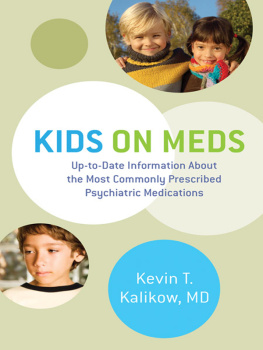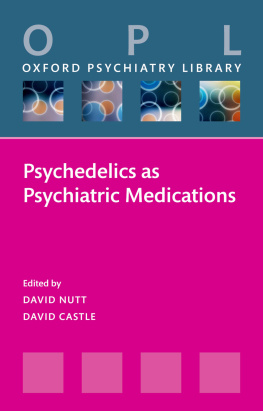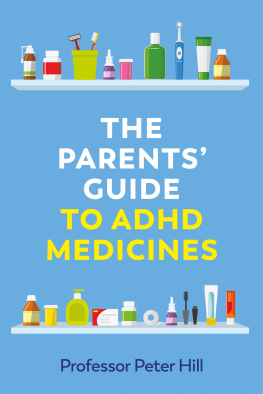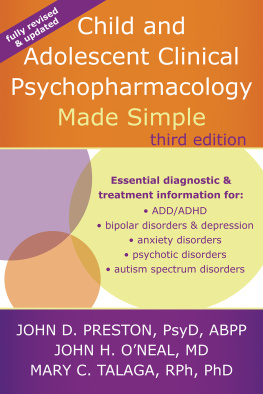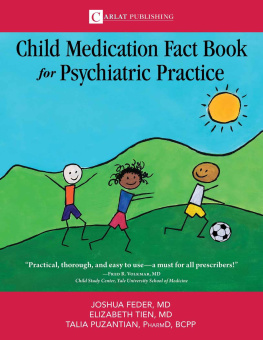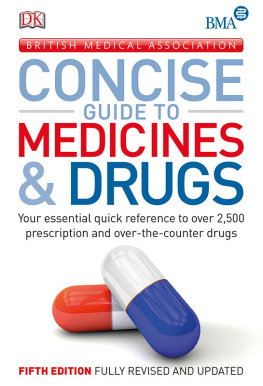Acknowledgements
M any people supported me in writing this book. I am indebted to them all. The faith of Deborah Malmud at W. W. Norton prompted this project. Libby Burton, Vani Kannan, Amanda Heller, and Kevin Olsen at Norton all provided expert guidance.
I am appreciative to my friends and colleagues Ronald Emerson, MD, Alan Kantor, MD, Michael Gewitz, MD, and Jamie Greene, PhD, for reading sections of the book. I am particularly thankful to Boris Birmaher, MD, and Judith Owens, MD, who reviewed chapters. Their stepping up to help a colleague they do not know well was an inspiring example of collegiality.
I thank my agent, Danny Baror, who tends to the details necessary to keep this book on bookshelves. And, I thank my friends Robert Seaver, MD, and Mark Banschick, MD, for their ongoing support
I thank my home teamLauren, Josh, Jeff, Kate and Adamwho provided everything from editorial advice to tech support. And, finally, I am grateful to Adrian who encouraged me to write this book, but more importantly has been with me for every step.
CHAPTER 1
Getting Started
W riting a prescription for medicine is the last in a series of steps. It represents one, and rarely the only, choice of treatment that follows a careful evaluation of the patient who has presented with a complaint. Before beginning my discussion of general psychopharmacology and then the specific groups of medicines, I summarize the steps that should precede treatment with medication so that the use of medicine is couched in the reasonable expectations of patient and physician. These steps include taking a complete history and arriving at a tentative understanding of the problem.
Signs and Symptoms
In most cases the patient initiates contact with the clinician regarding a specific complaint. These complaints are called symptoms. They are by definition subjective and include aches and itches, blurry vision and double vision, urinary hesitancy and urinary urgency, feeling hot and feeling cold, and all the other complaints that bring the patient to seek medical attention. In child psychiatry these complaints include feeling worried or sad, being full of rage or apathy, having racing thoughts and disorganized thoughts, and much more.
An interesting rub of child psychiatry is that the inherently subjective complaint usually comes from a person other than the patient, namely the parent or caregiver. This raises a number of issues. For example, the clinician must ascertain the subjective experience of the young child, who often does not understand the parent's motivation for the consultation or cannot easily articulate his or her own feelings. Or the clinician must hear from the very articulate adolescent who only wants to assert his or her independence or guard his or her self-image by denying that the parent's complaint has any resemblance to reality.
Signs, by contrast, are distinct from symptoms in that they are the physician's clinical findings and are, ideally, objective. The signs of clinical medicine include what the physician sees, hears, feels, and finds by various tests, whether taking a blood pressure or viewing a magnetic resonance imaging (MRI). These findings can be described and measured. So while the patient might complain of the symptom of feeling hot, the physician describes the patient's sign as a fever of 103 degrees. The signs of child psychiatry are more difficult to measure than those of general medicine, but they include such observations as a sad face, fidgetiness, lack of eye contact, fast speech, and lack of focus. As can be seen, mental health professionals are at a distinct disadvantage in not being able to quantify these signs easily.
For thousands of years, diagnosis and treatment were based solely on a careful evaluation of symptoms and signs. With the advent of modern technology, the world of signs available to the physician has expanded dramatically from the simple measurement of blood sugar to the measurement of images on an MRI and beyond. In clinical child psychiatry, however, we are largely without the technology that has been such a help to the rest of medicine. The high-tech instruments that measure the anatomy and functioning of the brain are used as the tools of research, not usually for patient care. Besides those, our most sophisticated tools, beyond our observational skills, are rating scales completed by patients, parents, teachers, and clinicians and the psychological tests performed by psychologists. While these can be valuable aids in understanding the patient, there is still a premium on carefully watching and listening to the patient and his or her family. Admittedly, however, the lack of clear standards of measurement leaves gray zones around the diagnosis of psychiatric disorders in children and makes the clinician vulnerable to using a diagnosis reached on a less-than-objective basis. This can ultimately affect the treatment plan, including whether medicine is prescribed.
The Evaluation
Taking a careful history of the patient's symptoms and comparing them with the signs observed by the clinician is the essence of the psychiatric evaluation of the child and adolescent and should precede the decision to use any treatment, obviously including medicine. The difficult task of trying to understand the mental life of a maturing and ever-changing child demands a careful evaluation of the many spheres of the child's life. Most experienced clinicians hold that a careful initial history is the single most important element of the evaluation.
Different clinicians have different styles of accomplishing this task, and every clinician will vary his or her style depending on the age of the child and the specifics of a given situation. In general, however, for preadolescent children, I initially speak with parents for an extended period. During this meeting I ascertain the details of the current problem as well as a history of the other areas of the child's life, including topics such as early development, moods, friendships, and family relationships. School history includes information about both academics and behavior and is obtained by speaking directly with and sometimes through consulting school staff or parents, and completing a rating scale. The baseline feedback of school staff can be very important to the clinician later in deciding whether a particular treatment is effective.
Reviewing the family's history of psychiatric disorders is also important, since it is becoming increasingly clear that although rates vary for different disorders, having a close blood relative with a given psychiatric disorder increases the possibility that a child will have that same disorder. In addition, knowing which family members have a psychiatric disorder helps the clinician understand the environment and family legacy with which a child lives. It is also helpful to know other family members' responses, both positive and negative, to different medicines, as this might help determine which medicine to prescribe to the child if medicine is indicated. Although my general rule is to start with a medicine approved by the U.S. Food and Drug Administration (FDA), if a parent or sibling has had a strongly positive response to a nonapproved medicine or a strongly negative response to an FDA-approved medicine, I reconsider that rule.
The child's medical history is also particularly important to any discussion of treatment with medicine. First, medical difficulties are unfortunately an important part of the life experience of some children and need to be noted if one is going to understand the child. Second, one needs to understand whether the child's presenting difficulties are caused by an underlying medical problem. For example, is the child's depression due to an underactive thyroid gland? Psychological explanations are sometimes too easily given, leaving the admittedly infrequent medical cause of psychiatric symptoms undiscovered. Biological problems can also be manifestations of psychiatric disorders. For example, sleep, appetite, and energy level can all be affected by depression. And finally, if medicine is going to be prescribed, the clinician must know whether any medical contraindications rule out the use of a specific medicine. For example, does a child's cardiac arrhythmia contraindicate the use of a stimulant for attention deficit hyperactivity disorder (ADHD)? Or does a history of obesity argue against the use of a second-generation antipsychotic?

